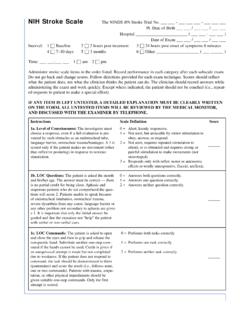Transcription of TTTThe Role of the TPAhe Role of the TPAhe Role …
1 The Role of the TPA in Self- Self-funding Edited by Paul Diamond Primary Author: Al Alison, Managing Director of the third party administrator Alliance With contributions from: Jennifer Kingsley-Wilson, Stephanie Cormier, Robby Kerr, Felicia Wilhelm, and Steve Graue. This article first appeared in the Standard Directory of third party Administrators 2008 Edition, a Publication of Judy Diamond Associates. Overview This article is meant to explain in clear terms the various types of work that a third party administrator (TPA) performs.
2 A TPA is generally defined as a company that administers self-funded employee benefit plans (such as health, welfare, workers' compensation, and retirement plans) on behalf of an employer or plan sponsor. This article will focus on defining the work spectrum of TPAs that administer health and workers' compensation plans. The term third party administrator is broad, and is defined differently by various sectors of the employee benefits industry. For the purposes of this article we will define a TPA as a state-licensed organization that adjudicates claims and provides administrative services on behalf of another organization's self-funded benefit plan.
3 A TPA may administer a variety of health and workers' compensation benefits including: medical, dental, vision, life, Rx, disability, voluntary benefits, consumer-directed health plans, and flexible spending plans. TPAs can also assist their clients with designing and implementing benefit plans, managing plans, and with billing/collecting of funds (or premiums) for distribution to the vendors involved. TPAs work on behalf of employers or plan sponsors as administrators and facilitators to outside vendors such as managing general underwriters, direct stop-loss writers, PPO.
4 Networks, EPO networks, POS providers, utilization review companies, pharmacy benefit managers, specialty pharmacies, home healthcare agencies, re-insurers, case managers, dental providers, life insurance companies, long- and short-term disability providers, nurse lines, customer service centers, specialty sub-acute care hospital networks, and other ancillary providers. TPAs may be independently owned and operated or can be owned by an insurance company, multi-employer group, or association. 1. While many TPAs fit into this broad definition, there are no standard practices or procedures that TPAs follow in regards to administration, work flow, or client servicing.
5 Each TPA works to the demands of its particular clients. Additionally, each TPA tends to define industry terms and even the role of a TPA differently. Fred Hunt, President of the Society of Professional Benefit Administrators (SPBA) has often said, When you've seen one TPA, you've seen one TPA. Factors of intense corporate individualism . across the TPA arena have caused confusion and misunderstanding regarding TPAs, the nature of their work, and the terms used to describe their work. This article defines the work that TPAs perform and is written for employers, benefit professionals, and those in the employee benefits arena.
6 Size and Scope of the TPA Market Place The Employees Benefit Research Institute (EBRI) issued a report in the year 2000, indicating that approximately 50 million workers and their dependents receive benefits through employer-sponsored, self-insured plans. According to the Self-Insurance Institute of America, Inc., (SIIA), this represents about 33% of the 150 million total participants in private employment-based plans nationwide. Self-funded Benefits TPAs administer self-funded benefits for employers.
7 This section will discuss and define self-funded benefits. Employers that elect to offer benefits to employees have two options for paying, or funding, those benefits. The two funding arrangements are: 1) Self-funded benefits: In this arrangement the employer (assisted by a consultant, agent, broker, or TPA) creates, defines and establishes a benefit plan (schedule of benefits) for its employees. Employee payroll deductions and employer contributions that would normally be used to pay an insurance policy premium are placed in a special fund for the sole purpose of paying employees' medical bills and fees as they are incurred.
8 In this arrangement the employer assumes the financial risk, as it must pay the medical bills of its employees that fall within the scope of the plan. The employer must calculate and create reserves to support the benefit plan. (Technically speaking, self-funded is a term that describes an employer that is responsible for 100% of the medical bills of its employees.). 2) Partially Self-funded benefits: In this arrangement the employer self-funds, but purchases aggregate stop-loss coverage or specific stop-loss coverage to protect against cases of catastrophic employee injury or illness which might create medical bills that are in excess of the funding that the company has on hand, and aggregate stop-loss to maximize the total exposure of the health plan.
9 Additionally an employer may choose to self-fund or partially self-fund dental and prescription drug benefits while opting to provide fully insured coverage for life, AD&D, and other ancillary benefits. Self-funding differs from fully-insured benefits (insurance policies) in many ways. Fully insured policies require monthly premiums to an insurance company in exchange for a 2. predefined (and limited) set of services, such as healthcare. Typically the employer will deduct money from an employee's pay to cover some or all of the premium costs.
10 In this arrangement the employer assumes no financial risk, beyond premium payments, for the healthcare or benefits provided to its employees. Companies tend to choose a funding arrangement for their benefits based on what option will provide the most amount of coverage for the least expense. Generally companies with less than 100 employees find that fully insured benefits are the most cost-effective route, while companies with over 100 employees have an economy of scale that can make partial self-funding a more cost-effective option.




